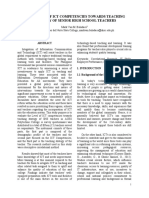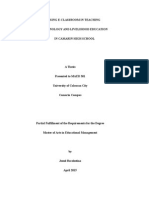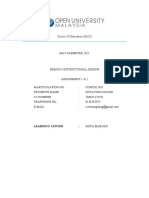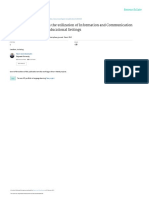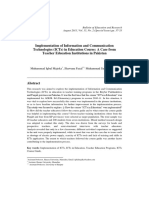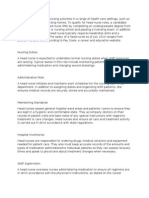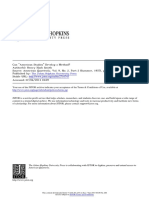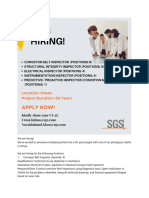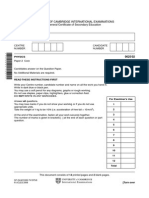Professional Documents
Culture Documents
Information Communication Technology Appraisal
Copyright
Available Formats
Share this document
Did you find this document useful?
Is this content inappropriate?
Report this DocumentCopyright:
Available Formats
Information Communication Technology Appraisal
Copyright:
Available Formats
Volume 5, Issue 3, March – 2020 International Journal of Innovative Science and Research Technology
ISSN No:-2456-2165
Information Communication Technology Appraisal
for Enhancement of Quality Education in North-
Wollo District, Amhara Region, Ethiopia
Lema Misgan*, Andualem Chekol
1
Department of information technology, institute of technology, Woldia University, Ethiopia
Abstract:- An attempt has been done in this study to school encounters to work rehearses; to help make
assess the status and challenges of information monetary suitability for tomorrow's laborers, add to radical
communication technology (ICT) for the enhancement changes in school; to reinforce instructing and to give
of quality education in Ethiopian secondary schools. chances to an association between the school and the world
The study examined the availability and status of ICT (Ajayi, 2009). There are various advantages gotten from the
infrastructures, electricity, characterizing the levels of utilization of ICT instruments in improving quality training,
challenges of ICT, skills, and capability as well as the for example, the capacity for the student to pick when to
perception of teachers and principals towards ICT. The learn regardless of the topographical area without stress
descriptive survey design using a mixed research (Birhanu Moges, 2013). Furthermore, ICT likewise
methodology was used. A total of 375 samples were empowers students to find and investigate new
randomly and purposely selected from teachers, developments from specialists around the world (Birhanu
principals, and students in four schools of north-Wollo Moges, 2013). Thirdly, the presence of ICT into the
district in the Amhara region. A self-designed training framework will empower the conveyance of
questionnaire prepared for secondary schools and ICT educators to understudies, checking of student progress and
was used to collect the data for the study. Data collected evaluation should be possible opportune (Birhanu Moges,
for the study were analyzed using descriptive statistics 2013). (Olurunsola, 2007) expressed that through ICT,
such as percentage scores and frequency counts. As the instructive necessities have been met; it changes the
finding showed, the unavailability of ICT devices, requirements of training just as the potential procedures.
inconsistent technology usage by teachers and staff
because of lack of computer, poor internet connection As indicated by Oduma, 2014), ICT increment student
and lack of ICT skills make ICT infertile in enhancing inspiration and commitment, encourage the securing of
the quality of education. Moreover, the result of the essential aptitudes, encourages e-learning, encourages
study indicated that several other factors pull back the instructor re-preparing, holding and up-dating of least
implementation of ICT at the schools. Therefore, it is scholarly standard and arrangement of virtual library
recommended that the responsible principals should administrations. Additionally, (Anthony O., 2012) likewise
increase the budget for ICT infrastructures in schools portrayed extra advantages of ICT are worldwide access to
and ICT skills should be a mandatory skill for teachers. information, instant sharing of understanding and best
Policymakers should adopt a hybrid ICT integration practice, self-guided, incitements of experiential picking
model that takes into account comprehensive factors up, opening windows for new reasoning, an environment of
tailored to both technological and pedagogical aspects development, demonstrate and owing innovation.
are recommended. Observing at the advantage of schooling in population-
building and the populace blast in the secondary schools
Keywords:- Amhara region, Challenges, ICT, Quality of now a day, the usage of ICT in the teaching-learning
education. progression becomes vital (Ajayi, 2009). Instructing and
learning have gone past the educator remaining before a
I. INTRODUCTION gathering of understudies and dispersing data to them
without the understudies' satisfactory cooperation. The
A. Overview of ICT as a tool for quality education creator depicted that with the guide of ICT, instructors can
Ozoji in Jimoh (2007) characterized ICT as the take understudies past conventional cutoff points, guarantee
controlling and treating of information (images, texts, their satisfactory interest in the educating and learning
instruction, graphs) for use employing electronic and process and make essential conditions to test and
specialized gadgets, for example, PCs, cameras, and phone. investigate Ajayi, 2008).
(Ofodu, 2007) likewise allude to ICT as electronic or
mechanized gadgets, helped by human and intelligent Instructors as a key in of the teaching should have
materials that can be utilized for a wide scope of instructing innovative education including 1) application of technology
and learning just as for individual use. These days, the spot in Instruction, 2) basic computer operations and concepts 3)
of ICTs in instruction and the world, can't be undermined. personal and professional use of technology
Data and correspondence innovation has the possibilities to (Aktaruzzaman, 2011). (Nwosu and Ugbomo, 2012),
quicken, advance, and extend expertise; to persuade and portrayed that ICT significantly encourage the obtaining of
draw in understudies in figuring out how to help relate information, offering nations extraordinary chances to
IJISRT20MAR528 www.ijisrt.com 1422
Volume 5, Issue 3, March – 2020 International Journal of Innovative Science and Research Technology
ISSN No:-2456-2165
upgrade instructive frameworks, improve strategy plan and integrate and adopt ICT into various levels of the
execution, and enlarge the scope of chances for business educational system. ICT integration model refers to the use
people. of computer systems and the Internet to support teaching
and learning experience across the curriculum in the
ICT has affected the quality and amount of education system.
instructing, learning and research in the custom or
potentially separation training foundations utilizing it Some studies examine the integration and adoption of
(Gloria O., 2013). Indeed, even most correspondence ICTs for teaching and learning in various contexts.
specialists in the field of training concur that when (Tomaro, 2018) and (Sang, G., 2010) argues that techno-
appropriately utilized, ICT innovation holds an centric approach to ICTs in education may not bring its
extraordinary guarantee to improve educating and learning promising result, rather, policymakers, should look into and
(Ubogu, 2012). explore a comprehensive integration processes that take
Along these lines, if Ethiopia as a country needs to improve into account various factors, such as ICT skill and
quality in education the basics of ICT technologies in its knowledge, the attitudes of both teachers and students play
education framework need critical consideration (Birhanu a great role in ICT integration in education system. (Oye N.
Moges, 2013). Improving the nature of instruction and D., 2012) presented the benefits of integrating ICT in
preparing is a basic issue, especially during a period of school counseling are so great that there is no need
instructive extension. ICT can improve the nature of justification as to why there is an urgent need to undertake
education in different ways; this incorporates expanding integrating ICT in school counseling for the basic
student inspiration and commitment, encouraging the education.
securing of essential abilities, and upgrading instructor
preparing, (Aktaruzzaman, 2011). According to (Capuk, S., 2015), to integrate ICT into
the educational system, curriculum development in the ICT
Regardless of whether there might be many pulling knowledge domain should be given great emphasis on
factors for poor education quality, but utilizing ICT various categories of knowledge such as Content
improperly, educators' ICT competency, understudies' ICT Knowledge, Curriculum knowledge, Pedagogical content
abilities, tendency and inspiration to utilize ICT, ICT and knowledge and Knowledge of learners. (Ng, W.K., 2009),
instructive framework integration point, ICT foundations, pointed out that a great emphasis should be given capacity
electricity issues were surveyed. The general goal of the building in technology integration that might be of
investigation was to evaluate the status and difficulties of relevance based on the needs of a given country, as shown
ICT innovations for the improvement of education quality in figure 1. Furthermore, the author argued that there is a
on Kobo and Lalibela secondary schools. According to our tendency to emphasize the installation of ICT over the
survey made, then north-Wollos’ secondary schools had seamless integration of ICT in teaching and learning i.e.,
poor ICT infrastructures, poor ICT competency of teachers, making ICT a part of the education setting and ensuring
very weak student to computer ratio, lack of internet- that it results in improved learning outcomes and qualify
connected laboratories, lack of awareness of teachers and learner engagement. However, Policymakers should clearly
principals in educational technologies. state how the process of adoption and integration of ICT
into the educational system should proceed; determine the
B. ICT Integration model into the curriculum educational purposes that technologies are to serve before
The promise of Information Communication they brought on implementation. It is important to note that
Technology (ICT) into the education system is crucial and ICT is only a tool and as such, it cannot compensate for
will remain to be a subject of great significance. One weakness in education policy.
intriguing question that gets great attention is how to
Fig 1:- Stages of ICT integration Ng, W.K, (2009)
IJISRT20MAR528 www.ijisrt.com 1423
Volume 5, Issue 3, March – 2020 International Journal of Innovative Science and Research Technology
ISSN No:-2456-2165
As is illustrated in figure -3, in the first stage, teachers the data were collected through interviews, observation and
and learners are exposed to discover ICT tools and their focus group discussion was conducted using purposive
general functions and uses, and the emphasis is given ICT sampling from the non-probability sampling technique.
literacy and basic skills. The second stage involves how to
use ICT tools, and making use of them in different The testing size would be 375 and chosen dependent
disciplines (subjects). This includes the use of general as on Yamane's formula (Kasiulevičius, 2006), for finding a
well as a particular application of ICT tools, and it relates minimum sample size from a known population. The
to applying stages. In the third stage, there is a clear formula is.
understanding of how and when to use it. This implies the
ability to recognize situations where ICT will be a potential N
𝑛= Where n=the sample size
1+N𝑒 2
solution to solve real problems. This relates to the infusing
stage.
N= the size of the population and e= the error of 5
percentage or with the confidence coefficient of 95%
At the final stage, it is the process of transforming the
(Kasiulevičius, 2006).
learning situation via the use of ICT. This stage requires a
new way of approaching a teaching-learning environment
As per data from the North-Wollo zone education
with well customized and fine-tuned ICT tools.
office, the schools have the sum of 6051 population. So we
had had a sample size of n=6051/1+6051(0.05)2=375.
This paper is divided into parts. Part 1 was about the
introduction, part 2 is about methods and techniques, part 3
D. Methods of Data Collection
is about result and discussion, part 4 is about conclusion
To get adequate and complementary information for
and recommendation finally the last part is a list of
the study, a diverse set of data gathering instruments were
references.
employed. Observations were used since to get contextual
information especially the level of ICT infrastructures,
II. RESEARCH METHODS
available infrastructures types, their qualities, teacher's and
students' level of competence in the schools were observed.
A. Description of the Study Area
A questionnaire composed of both closed-ended and open-
North-Wollo is situated in the northern course of
ended questions, to draw out information on respondents’
Addis Ababa. The focal point of the zone is Woldia town
attitudes and beliefs as well as ICT skills towards ICT in
and the town is around 521-kilo meters away. According to
improving the quality of education. Interview of school
the central statistical agency of Ethiopia (CSA, 2007), the
principals, ICT teachers and technicians to get the overall
zone has an all-out populace of 1,500,303. In this zone,
status of ICT infrastructures and FGD was also used to
there were a total of 73 secondary schools. The objective
strengthen all the collected data using other instruments
schools were chosen dependent on efficient arbitrary
from all of principals, general course teachers, ICT
examining utilizing a lottery strategy wherein the 73
teachers, technicians, and students.
secondary schools were recorded on paper by separating
into two gatherings A) bunch I, were schools with
E. Method of Data Analysis
acceptable ICT foundation for the most part PC and related,
Descriptive statistics analysis techniques such as
B) bunch II schools with some way or another less
frequency counts and percentage scores were used.
framework, because of their gathering, schools chose by
Qualitatively the data were analyzed through narration
lottery method and from that has great ICT framework
which consists of analyzing the contents of all verbal and
Lalibela was chosen and from less foundation kobo was
written materials, which made it appropriate to analyze
chosen.
both documents collected through data collection tools of
the interview, FGD, and observation.
B. Nature and Types of Data and Research Design
The descriptive survey was used for this study in
III. RESULT AND DISCUSSION
which a blend of both quantitative and qualitative data was
collected and analyzed.
A. Result:
Lalibela secondary schools have a total of 2582
C. Sampling Techniques and Procedures
students and 226 computers. The student to computer ratio
The sampling technique was blended (probability and
is 11:1. However, the school has only 66 instructional
non-probability) types of sampling techniques. Simple
computers and the other 160 computers are only used for E-
random sampling and stratified random sampling from
learning and are not used for day to day instructions.
probability sampling techniques were applied. But some of
No Recommended Ratio Kobo Ratio Lalibela Ratio
1 3:1 (Student to computer) 80:1 (26.6 times of the recommended 39:1(13 times of the
ratio) recommended ratio)
Table 1:- Student to computer ratio comparison
IJISRT20MAR528 www.ijisrt.com 1424
Volume 5, Issue 3, March – 2020 International Journal of Innovative Science and Research Technology
ISSN No:-2456-2165
A comparison of teacher’s purpose of using computers and an internet in the schools indicated in Figure 2, below.
Fig 2:- Teacher’s ICT tools usage
NB. 1) Using computers for common day to day tasks indicates Microsoft office applications, internet browsing, and online
education, using an LCD projector in a class, using ICT machines (printers, scanners, copiers).2) Using Computers for educational
purposes indicates:- Preparing a teaching material, teaching in the classroom using ICT tools, for educational video tutorials, for
research. 3) Using the internet for social media indicates:- For face-book, Telegram, Imo, Whatsup, Viber.
o Explanation of basic ICT related abilities High Medium Low None
N
Rate Frequency Rate Frequency Rate Frequency Rate Frequency
(%) (%) (%) (%)
1 Working with word-processor applications 11/40 27.5 12/40 30 9/40 22.5 8/40 20
(example: Microsoft Word)
2 Working with spreadsheet applications 7/40 17.5 10/40 25 12/40 30 11/40 27.5
(example: Microsoft Excel)
3 Working with databases tools 7/40 17.5 5/40 12.5 8/40 20 20/40 50
(Example: Microsoft Access)
4 Ability of using electronic mail 12/40 30 2/40 5 10/40 25 16/40 40
5 Searching data using search engines 16/40 40 9/40 22.5 4/40 10 11/40 27.5
(example: Google, yahoo)
6 Using online teaching and learning 5/40 12.5 1/40 2.5 10/40 10 24/40 60
materials
7 Uploading and downloading different 15/40 37.5 6/40 15 6/40 15 13/40 32.5
materials
8 Using educational e-libraries 5/40 12.5 9/40 22.5 7/40 17.5 19/40 47.5
9 Working with PowerPoint (presentation 7/40 17.5 5/40 12.5 11/40 27.5 17/40 42.5
tools)
10 Skills to use LCD projector for teaching 3/40 7.5 4/40 10 10/40 25 23/40
11 Abilities to operate printers and related 10/40 25 8/40 20 7/40 17.5 15/40
peripherals
Table 2:- Competency of teachers on ICT
IJISRT20MAR528 www.ijisrt.com 1425
Volume 5, Issue 3, March – 2020 International Journal of Innovative Science and Research Technology
ISSN No:-2456-2165
Keys: HighI have good experience on it.
MediumI have some experience on it.
LowI have seen how people use it.
None I have no experience on it.
Fig 3:- The challenges of ICT to enhance the quality of education
B. Discussion The study evaluates the status of the schools using the
The student-to-computer ratio recommended by the above indicators and criteria. Kobo secondary schools have
U.S. Department of Education is 3:1, according to (Lucinda a total of 3225 students and 160 computers. Therefore, the
Gray, 2010). According to the president's committee of student to computer ratio is 20:1 more than six times the
advisors on science and technology, 4 to 5 students per recommended ratio. But badly the school has only 40
computer is the ratio that many experts consider to instructional computers and the other 120 computers are
representing a reasonable level for the effective use of used for E-learning and are not used for day to day
computers within the schools. The degree of participation instructions. Therefore, the ratio of students to instructional
in the use of ICT in education for a given country could be computers becomes 80:1, which is 26.6 times of the
affected by several factors like cost of facilities, recommended ratio.
infrastructure, literacy level, availability of human
resources, cultural attitudes and ignorance (Diana Kessy, The result showed that even if 42% of the total
2006). One of the major challenges facing developing respondents of Kobo secondary school teachers that have
countries is to make technology an essential part of the the skill, only 21% of them are using computers for
culture of the people, (Abdulkafi Albirini, 2006). The educational purposes and this means that the remaining
reverence with which technology is held in technologically 79% are using computers for none educational purpose. But
developed countries may be in contradiction to the 93% of them are using the internet for accessing social
perceptions of cultures that are relationship-oriented. media only from all populations using their cell phone.
Indicators of ICT in education are computer & internet
access, ICT usage of teacher & student in school, the
infrastructure of ICT use in education and competency of
students ICT skills (Song, K.-S, 2013).
IJISRT20MAR528 www.ijisrt.com 1426
Volume 5, Issue 3, March – 2020 International Journal of Innovative Science and Research Technology
ISSN No:-2456-2165
Comparatively, teachers in Lalibela secondary schools Policymakers should give great emphasis for capacity
have a lower number of staff (28%) of them are using building in technology integration that might be of
computers for educational purposes and 91% of them are relevance based on the needs of a given country. Based on
using the internet for accessing social media, which is (Ng W.K, 2009) ICT integration stages, an effective
almost similar to Kobo schools. integration model is adapted given this study finding as an
input that depicts the status and ICT usage in the existing
The overall finding of this study showed that educational system.
Ethiopian secondary schools are lagging in using ICT
technologies for the teaching-learning process due to the The devised integration model is consists of two
lack of ICT competency of teachers, students, and approaches. It is a hybrid model that comprises what to
principals. Lack of ICT infrastructures, lack of motivation include in the existing educational system such as
towards skills of ICT, Weak integration point of ICT to curriculum development in the ICT knowledge domain. It
GEDIP, using the existing infrastructures for non-academic includes also the second component that depicts the
purposes are major outcomes. processes of implementation which guide the integration
process in four stages with a feedback loop.
Recommended ICT Integration model
Fig 4:- Hybrid ICT Integration model
In summary, progression through these stages of ICT capacity building training should tie to and within
integrating process would take a significant amount of time the context of classroom objectives and activities.
and requires a holistic view and solution due to the reason
that it requires more than just purchasing cutting edge ICT School-based training of teachers should be delivered in
tools and equipping teachers' handful skill training. peer to peer mode rather than a convention training
lecturing mode.
The following lesson should be taken into account Teachers should learn how to use the ICT tools more
when training teachers' ICT capacity building training in effectively when they see the technologies not as
the process of ICT integration. These are: generic and decontextualized tools but as tools for
IJISRT20MAR528 www.ijisrt.com 1427
Volume 5, Issue 3, March – 2020 International Journal of Innovative Science and Research Technology
ISSN No:-2456-2165
teaching, that is, for motivating, managing, facilitating, instruction, and Internet-assisted instruction should be
enhancing, and evaluating learning. employed effectively. Internet Laboratories available in
schools have to be clean and accessible and connect
Moreover, Policymakers and respective stakeholders with more computers.
should give great emphasis to develop capacity in holistic Disorientation towards affordable ICT and general
and systematic policy formulation and strategic planning education integration in Ethiopian secondary schools
for ICT integration. It should give high priority to the needs further research.
pivotal role of the teachers that play in ensuring the
appropriate, effective, and sustainable use of ICT to ACKNOWLEDGMENT
provide quality education for all. For this to happen, a
careful design of a comprehensive ICT focuses on Teacher We acknowledge and greatly appreciate Woldia
Professional Development that powers the teacher is not University for financial sponsorship to conduct this
just implementer but also to lead the sectors. Policymakers research in the selected high school to fill the gaps of the
need to decide on what type of ICT integration approach to students and teachers regarding ICT and Lalibela and Kobo
adopt in the given educational curriculum. woreda for providing necessary data for the study.
IV. CONCLUSION AND RECOMMENDATION REFERENCES
A. Conclusion [1]. Ajayi, A., 2008. Towards effective use of Information
The purpose of this research was to appraise the status and Communication Technology (ICT) for teaching in
and challenges of information communication technology Nigerian Colleges of Education. Asian Journal of
for the enhancement of quality education in north-Wollo Information Technology, 7(5), pp.210-214.
district secondary schools. The finding of this study showed [2]. Ajayi, I.A. and Ekundayo, H.T., 2009. The application
that Ethiopian secondary schools are lagging in using ICT of information and communication technology in
technologies for the teaching-learning process. Despite Nigerian secondary schools. International NGO
many advantages of ICT to enhance the quality of Journal, 4(5), pp.281-286.
education, teachers' students, as well as principals, are not [3]. Aktaruzzaman, M., Shamim, M.R. and Clement, C.K.,
using ICT technologies. The factors that hinder the 2011. Trends and issues to integrate ICT in teaching
technology are lack of motivation, lack of skills, lack of learning for the future world of
awareness, lack of devices available, integration problems education. International Journal of Engineering &
are major reasons. Technology, 11(3), pp.114-119.
[4]. Albirini, A., 2006. Cultural perceptions: The missing
This study finds out that the existing ICT integration element in the implementation of ICT in developing
model has lacked some important aspects that help to countries. International Journal of Education and
enhance the quality of education. Therefore, this study development using ICT, 2(1), pp.49-65.
adopts an effective ICT Integration model that helps to [5]. Anthony, O., 2012. Challenges of effective use of ICT
enhance the quality of education. as a tool for implementing the UBE scheme. In 53rd
Annual Conference of Science Teachers Association
Finally, to improve the students’ quality of education of Nigeria. HEBN Publishers. Vol. 3 No. 9
all responsible bodies should give attention to the problems [6]. , pp. 127-131.
listed in the result session and should go through the [7]. Çapuk, S., 2015. ICT Integration models into the
solutions and ICT can be subject, and can be a tool which middle and high school curriculum in the USA.
used to teach other subjects, or to access information, Procedia-Social and Behavioral Sciences, 191,
communicate with others. Therefore, it should be integrated pp.1218-1224.
into our education curriculum carefully starting from [8]. Drent, M. and Meelissen, M., 2008. Which factors
primary schools and the problems listed should be solved obstruct or stimulate teacher educators to use ICT
accordingly. innovatively?. Computers & Education, 51(1),
pp.187-199.
B. Recommendation [9]. Fan, C.W. and Ho, K.K., 2012. A tale of three cities:
It is recommended that a hybrid ICT integration model Review of the development of ICT in school
that takes into account comprehensive factors tailored to education between Hong Kong, Macau and
both technological and pedagogical aspect. Singapore. New Horizons in Education, 60(1), pp.70-
Policymakers and the educational practitioners should 82.
give a higher priority and emphasis by considering [10]. Jimoh, A.T., 2007. Students' attitudes towards ICT in
major aspects of integration model such as, emerging, Nigeria tertiary institutions. Education Focus, 1(1),
applying, infusing and transforming stages. pp.73-79.
ICT should be a mandatory skill for all levels of [11]. Kessy, D., Kaemba, M. and Gachoka, M., 2006, July.
teachers and teachers should get a basic computer and The reasons for under use of ICT in education: In the
internet browsing skills training regularly. context of Kenya, Tanzania, and Zambia. In Fourth
ICT-assisted instruction, it includes, all or combinations IEEE International Workshop on Technology for
of Television-assisted instruction, Computer-assisted
IJISRT20MAR528 www.ijisrt.com 1428
Volume 5, Issue 3, March – 2020 International Journal of Innovative Science and Research Technology
ISSN No:-2456-2165
Education in Developing Countries (TEDC'06) (pp.
83-87). IEEE.
[12]. Moges, B., 2013. The role of information and
communication technology (ICT) in enhancing the
quality education of Ethiopian universities: A review
of literature. Journal of Education Research and
Behavioral Sciences, 3(8), pp.246-258.
[13]. Ng, W.K., Miao, F. and Lee, M., 2009. Capacity-
building for ICT integration in education. Digital
Review of Asia Pacific, 2010, pp.67-76.
[14]. Nwosu, O. and Ogbomo, E.F., 2011. ICT in
education: A catalyst for effective use of
information. Pacific Northwest Library Association,
PNLA Quarterly, 75(4), p.54.
[15]. Oduma, C.A., 2014. Quality assurance in education:
The role of ICT and quality control measures in
tertiary institutions in Nigeria. AFRREV STECH: An
International Journal of Science and
Technology, 3(2), pp.136-158.
[16]. Ofodu, G.O., 2007. Nigeria literacy educators and
their technological needs in a digital age. Education
Focus, 1(1), pp.22-30.
[17]. Olorunsola, E.O., 2007. Information communication
technology. A tool for effective management in
Nigerian universities. Education Focus, 1(1), pp.80-
87.
[18]. Oye, N.D., Obi, M.C., Mohd, T.N. and Amos, B.,
2012. Guidance and counseling in Nigerian secondary
schools: The role of ICT. International Journal of
Modern Education and Computer Science, 4(8), p.26.
[19]. Oyovwe-Tinuoye, G. and Adogbeji, B.O., 2013.
Information communication technologies (ICT) as an
enhancing tool in quality education for the
transformation of individual and the nation.
International Journal of Academic Research in
Business and Social Sciences, 3(4), p.21.
[20]. Song, K.S., Kim, H.S., Seo, J. and Kim, C.H., 2013.
Development and pilot test of ICT in education
readiness indicators in the global context. KEDI
Journal of Educational Policy, 10(2) , pp. 243-265
[21]. Tomaro, Q.P.V., 2018. ICT integration in the
educational system of Philippines. Journal of
Governance and Public Policy, 5(3), pp.259-282.
[22]. Ubogu, R.E. and Evarista, B.E., 2012. Challenges of
Utilizing Information and Communication
Technology (ICT) for Quality Education in Secondary
Schools in Delta State, Nigeria. Journal of
Communication and Culture, 3(2), pp.19-25.
IJISRT20MAR528 www.ijisrt.com 1429
You might also like
- Difficulties Faced by Teachers in Using ICT in Teaching-Learning at Technical and Higher Educational Institutions of UgandaDocument11 pagesDifficulties Faced by Teachers in Using ICT in Teaching-Learning at Technical and Higher Educational Institutions of UgandaAdaNo ratings yet
- Ict in EducationDocument22 pagesIct in EducationShasteen Bautista SantosNo ratings yet
- ICT Integration in Education: Incorporation For Teaching & Learning ImprovementDocument22 pagesICT Integration in Education: Incorporation For Teaching & Learning ImprovementJjfreak ReedsNo ratings yet
- An Assessment of ICT Competency Level of Grade 10 Students in Talon National High School Basis For ICT Skill Enhancement ProgramDocument22 pagesAn Assessment of ICT Competency Level of Grade 10 Students in Talon National High School Basis For ICT Skill Enhancement ProgramPao BorjaNo ratings yet
- Ict As A Tool PaperDocument5 pagesIct As A Tool PaperSALIHU ABDULGANIYUNo ratings yet
- An Evaluation of Technological Competences and Technological Tools Usage by Primary School Teachers During COVID-19 Lockdown in CameroonDocument8 pagesAn Evaluation of Technological Competences and Technological Tools Usage by Primary School Teachers During COVID-19 Lockdown in CameroonInternational Journal of Innovative Science and Research TechnologyNo ratings yet
- Article IJMH - Impact of ICT For The 21st Century - A Change Driving Tools For TE in NigDocument8 pagesArticle IJMH - Impact of ICT For The 21st Century - A Change Driving Tools For TE in NigMuhammad Muhammad SuleimanNo ratings yet
- Chapter One: (Tedla, 2012)Document32 pagesChapter One: (Tedla, 2012)Dawu LoveNo ratings yet
- Chapter TwoDocument2 pagesChapter TwoJoan EwurujeNo ratings yet
- 177-Article Text-327-1-10-20210331Document11 pages177-Article Text-327-1-10-20210331SamanNo ratings yet
- ICT in EducationDocument9 pagesICT in EducationPutri AryaniNo ratings yet
- A Cross Sectional Study of Teacher Attitude Towards The Use of Ict in Teaching Chemistry in Senior Secondary School in Gwale Local Government AreaDocument79 pagesA Cross Sectional Study of Teacher Attitude Towards The Use of Ict in Teaching Chemistry in Senior Secondary School in Gwale Local Government AreaDaniel ObasiNo ratings yet
- A Study On The Impact of IctDocument6 pagesA Study On The Impact of Ictkilling nightmare87No ratings yet
- TeachingStrategy Buladaco - EditedDocument15 pagesTeachingStrategy Buladaco - EditedMyer Reign MendozaNo ratings yet
- TeachingStrategy Buladaco - EditedDocument15 pagesTeachingStrategy Buladaco - EditedEmilene Panganiban Raniaga-MuñozNo ratings yet
- Project Solo After ProposalDocument109 pagesProject Solo After ProposalLoyd J RexxNo ratings yet
- Effectiveness of InformationDocument9 pagesEffectiveness of InformationEra MusaNo ratings yet
- Assessing The Use of ICT in Teaching Amd LearningDocument18 pagesAssessing The Use of ICT in Teaching Amd LearningKagyera KatakaraNo ratings yet
- Ict and Critical ThinkingDocument5 pagesIct and Critical Thinkingnalova endeleyNo ratings yet
- ICT Integration Barriers in Pakistan's Education SystemDocument13 pagesICT Integration Barriers in Pakistan's Education SystemMuhammad JawadNo ratings yet
- Effects of Computer Usage On Students PerformanceDocument18 pagesEffects of Computer Usage On Students PerformanceAbdul-Fatawu Ibn Ibrahim Doctah67% (3)
- Constraint To Effective Use of ICT On Islamic Education A Critical Analysis of Public and Private Secondary SchoolDocument7 pagesConstraint To Effective Use of ICT On Islamic Education A Critical Analysis of Public and Private Secondary SchoolEditor IJTSRDNo ratings yet
- Accepting ICT ChallengesDocument18 pagesAccepting ICT ChallengesMuya BarawcorNo ratings yet
- ICT and Commerce TeachingDocument2 pagesICT and Commerce TeachingRitu ChakravartyNo ratings yet
- Assessing The Impact of ICT in TeachingDocument50 pagesAssessing The Impact of ICT in TeachingEric AmankwaNo ratings yet
- Jimma University College of Computing Department of Information ScienceDocument8 pagesJimma University College of Computing Department of Information ScienceYeabsira Workagegnehu100% (1)
- Media LiteracyDocument5 pagesMedia LiteracyEmmanuel Jimenez-Bacud, CSE-Professional,BA-MA Pol SciNo ratings yet
- Model Bersepadu Penerapan Kemahiran Abad Ke-21 Dalam Pengajaran Dan PembelajaranDocument4 pagesModel Bersepadu Penerapan Kemahiran Abad Ke-21 Dalam Pengajaran Dan PembelajaranVenissa UgunNo ratings yet
- Thesis Ni Mam JesselDocument15 pagesThesis Ni Mam JesselNylram Sentoymontomo AiromlavNo ratings yet
- Instructional DesignDocument46 pagesInstructional DesignOctavius GuNo ratings yet
- Sample Full Blown Quantitative Research ICT Competency LevelDocument105 pagesSample Full Blown Quantitative Research ICT Competency LevelJanineAlvaradoNo ratings yet
- Applications of Ict To Enhancing Basic Education in NigeriaDocument4 pagesApplications of Ict To Enhancing Basic Education in NigeriaopepolawalNo ratings yet
- SSRN-id3377617Document6 pagesSSRN-id3377617Shahbaz SikandarNo ratings yet
- Concept PaperDocument15 pagesConcept PaperElla Blanca BuyaNo ratings yet
- ArticleDocument5 pagesArticleJashlyn MirandaNo ratings yet
- ICT Competency Level of Teacher in The MUST: September 2017Document6 pagesICT Competency Level of Teacher in The MUST: September 2017Dino DizonNo ratings yet
- Chry - 2013 - The Use of ICT Tools in High School Education A Case Study in Stung Treng Province-AnnotatedDocument21 pagesChry - 2013 - The Use of ICT Tools in High School Education A Case Study in Stung Treng Province-AnnotatedSeng SokungNo ratings yet
- Journal Articles-Linda A. DelgacoDocument9 pagesJournal Articles-Linda A. DelgacoDada Aguilar DelgacoNo ratings yet
- Icts in Learning in Pakistan: International Journal of Evaluation and Research in Education (Ijere)Document10 pagesIcts in Learning in Pakistan: International Journal of Evaluation and Research in Education (Ijere)Muhammad Malik HakimNo ratings yet
- Research Into ICT Integration in Pakistan Secondaaary SchoolsDocument11 pagesResearch Into ICT Integration in Pakistan Secondaaary SchoolsKeshawn PaulNo ratings yet
- Barriers To Effective Integration of Inf PDFDocument6 pagesBarriers To Effective Integration of Inf PDFAziraZana HammidNo ratings yet
- A Theoretical Overview On The Utilization of Information and Communication Technology (ICT) in The Educational SettingsDocument4 pagesA Theoretical Overview On The Utilization of Information and Communication Technology (ICT) in The Educational SettingsRifaNo ratings yet
- Article4 PDFDocument20 pagesArticle4 PDFMickle jay PaccialNo ratings yet
- Factors PDFDocument20 pagesFactors PDFKiran KaurNo ratings yet
- Challenges of Ict For Teachers in MadrasaDocument9 pagesChallenges of Ict For Teachers in MadrasaAnonymous CwJeBCAXpNo ratings yet
- Chapter 1 PR1Document7 pagesChapter 1 PR1tjybzenNo ratings yet
- Teaching and Learning With Technology: Eff Ectiveness of ICT Integration in SchoolsDocument19 pagesTeaching and Learning With Technology: Eff Ectiveness of ICT Integration in SchoolsMelody Dacquel-GahidNo ratings yet
- Role of ICT in Digital Learning &teaching AspectsDocument3 pagesRole of ICT in Digital Learning &teaching Aspectsashish chaturvediNo ratings yet
- V1.3 - 100 Angodi Fullr FPRDocument8 pagesV1.3 - 100 Angodi Fullr FPRaswardiNo ratings yet
- Strategies For Integrating Ict Into The Teaching of AgriDocument28 pagesStrategies For Integrating Ict Into The Teaching of AgrienyichukwuebubechukwuNo ratings yet
- ICT-Pedagogy Integration in Teacher Training: Application Cases WorldwideDocument8 pagesICT-Pedagogy Integration in Teacher Training: Application Cases WorldwidecutitoutsirNo ratings yet
- Assessment of Pre-Service Teachers' Satisfaction On The Frequency and Mode of Ict Use in Teacher-Training Programmes in Nigerian UniversitiesDocument16 pagesAssessment of Pre-Service Teachers' Satisfaction On The Frequency and Mode of Ict Use in Teacher-Training Programmes in Nigerian UniversitiesdotunolagbajuNo ratings yet
- APJMR 2014-2-164 Preparedness and Attitude of College Students Toward ICT BasedDocument8 pagesAPJMR 2014-2-164 Preparedness and Attitude of College Students Toward ICT BasedAsia Pacific Journal of Multidisciplinary ResearchNo ratings yet
- ICT Implementation in Teacher EducationDocument17 pagesICT Implementation in Teacher EducationShah KhaksaarNo ratings yet
- Perception of Teachers On EffectivenessDocument11 pagesPerception of Teachers On Effectivenessandiade irmaNo ratings yet
- The Prevalence of Computer Assisted TeacDocument8 pagesThe Prevalence of Computer Assisted TeacShaaira Hoosen Mahomed RazakNo ratings yet
- ProjectDocument32 pagesProjectSt CharlesNo ratings yet
- ICT Integration in ClassroomDocument21 pagesICT Integration in ClassroomMICHAEL LOUI SULITNo ratings yet
- Integration of Icts in Higher Education To Promote Students' LearningDocument6 pagesIntegration of Icts in Higher Education To Promote Students' LearningTJPRC PublicationsNo ratings yet
- Teaching and Learning in Technology Empowered Classrooms—Issues, Contexts and PracticesFrom EverandTeaching and Learning in Technology Empowered Classrooms—Issues, Contexts and PracticesNo ratings yet
- Improvement Functional Capacity In Adult After Percutaneous ASD ClosureDocument7 pagesImprovement Functional Capacity In Adult After Percutaneous ASD ClosureInternational Journal of Innovative Science and Research TechnologyNo ratings yet
- Machine Learning and Big Data Analytics for Precision Cardiac RiskStratification and Heart DiseasesDocument6 pagesMachine Learning and Big Data Analytics for Precision Cardiac RiskStratification and Heart DiseasesInternational Journal of Innovative Science and Research TechnologyNo ratings yet
- Optimization of Process Parameters for Turning Operation on D3 Die SteelDocument4 pagesOptimization of Process Parameters for Turning Operation on D3 Die SteelInternational Journal of Innovative Science and Research TechnologyNo ratings yet
- Design and Implementation of Homemade Food Delivery Mobile Application Using Flutter-FlowDocument7 pagesDesign and Implementation of Homemade Food Delivery Mobile Application Using Flutter-FlowInternational Journal of Innovative Science and Research TechnologyNo ratings yet
- Enhancing Biometric Attendance Systems for Educational InstitutionsDocument7 pagesEnhancing Biometric Attendance Systems for Educational InstitutionsInternational Journal of Innovative Science and Research TechnologyNo ratings yet
- Forensic Evidence Management Using Blockchain TechnologyDocument6 pagesForensic Evidence Management Using Blockchain TechnologyInternational Journal of Innovative Science and Research TechnologyNo ratings yet
- Food habits and food inflation in the US and India; An experience in Covid-19 pandemicDocument3 pagesFood habits and food inflation in the US and India; An experience in Covid-19 pandemicInternational Journal of Innovative Science and Research TechnologyNo ratings yet
- Late Presentation of Pulmonary Hypertension Crisis Concurrent with Atrial Arrhythmia after Atrial Septal Defect Device ClosureDocument12 pagesLate Presentation of Pulmonary Hypertension Crisis Concurrent with Atrial Arrhythmia after Atrial Septal Defect Device ClosureInternational Journal of Innovative Science and Research TechnologyNo ratings yet
- Scrolls, Likes, and Filters: The New Age Factor Causing Body Image IssuesDocument6 pagesScrolls, Likes, and Filters: The New Age Factor Causing Body Image IssuesInternational Journal of Innovative Science and Research TechnologyNo ratings yet
- Severe Residual Pulmonary Stenosis after Surgical Repair of Tetralogy of Fallot: What’s Our Next Strategy?Document11 pagesSevere Residual Pulmonary Stenosis after Surgical Repair of Tetralogy of Fallot: What’s Our Next Strategy?International Journal of Innovative Science and Research TechnologyNo ratings yet
- The Students’ Assessment of Family Influences on their Academic MotivationDocument8 pagesThe Students’ Assessment of Family Influences on their Academic MotivationInternational Journal of Innovative Science and Research Technology100% (1)
- Blockchain-Enabled Security Solutions for Medical Device Integrity and Provenance in Cloud EnvironmentsDocument13 pagesBlockchain-Enabled Security Solutions for Medical Device Integrity and Provenance in Cloud EnvironmentsInternational Journal of Innovative Science and Research TechnologyNo ratings yet
- A Review on Process Parameter Optimization in Material Extrusion Additive Manufacturing using ThermoplasticDocument4 pagesA Review on Process Parameter Optimization in Material Extrusion Additive Manufacturing using ThermoplasticInternational Journal of Innovative Science and Research TechnologyNo ratings yet
- Quality By Plan Approach-To Explanatory Strategy ApprovalDocument4 pagesQuality By Plan Approach-To Explanatory Strategy ApprovalInternational Journal of Innovative Science and Research TechnologyNo ratings yet
- Design and Development of Controller for Electric VehicleDocument4 pagesDesign and Development of Controller for Electric VehicleInternational Journal of Innovative Science and Research TechnologyNo ratings yet
- Administration Consultancy Administrations, a Survival Methodology for Little and Medium Undertakings (SMEs): The Thailand InvolvementDocument4 pagesAdministration Consultancy Administrations, a Survival Methodology for Little and Medium Undertakings (SMEs): The Thailand InvolvementInternational Journal of Innovative Science and Research TechnologyNo ratings yet
- The Experiences of Non-PE Teachers in Teaching First Aid and Emergency Response: A Phenomenological StudyDocument89 pagesThe Experiences of Non-PE Teachers in Teaching First Aid and Emergency Response: A Phenomenological StudyInternational Journal of Innovative Science and Research TechnologyNo ratings yet
- Targeted Drug Delivery through the Synthesis of Magnetite Nanoparticle by Co-Precipitation Method and Creating a Silica Coating on itDocument6 pagesTargeted Drug Delivery through the Synthesis of Magnetite Nanoparticle by Co-Precipitation Method and Creating a Silica Coating on itInternational Journal of Innovative Science and Research TechnologyNo ratings yet
- Gardening Business System Using CNN – With Plant Recognition FeatureDocument4 pagesGardening Business System Using CNN – With Plant Recognition FeatureInternational Journal of Innovative Science and Research TechnologyNo ratings yet
- Anxiety, Stress and Depression in Overseas Medical Students and its Associated Factors: A Descriptive Cross-Sectional Study at Jalalabad State University, Jalalabad, KyrgyzstanDocument7 pagesAnxiety, Stress and Depression in Overseas Medical Students and its Associated Factors: A Descriptive Cross-Sectional Study at Jalalabad State University, Jalalabad, KyrgyzstanInternational Journal of Innovative Science and Research Technology90% (10)
- Investigating the Impact of the Central Agricultural Research Institute's (CARI) Agricultural Extension Services on the Productivity and Livelihoods of Farmers in Bong County, Liberia, from 2013 to 2017Document12 pagesInvestigating the Impact of the Central Agricultural Research Institute's (CARI) Agricultural Extension Services on the Productivity and Livelihoods of Farmers in Bong County, Liberia, from 2013 to 2017International Journal of Innovative Science and Research TechnologyNo ratings yet
- Databricks- Data Intelligence Platform for Advanced Data ArchitectureDocument5 pagesDatabricks- Data Intelligence Platform for Advanced Data ArchitectureInternational Journal of Innovative Science and Research TechnologyNo ratings yet
- Comparison of Lateral Cephalograms with Photographs for Assessing Anterior Malar Prominence in Maharashtrian PopulationDocument8 pagesComparison of Lateral Cephalograms with Photographs for Assessing Anterior Malar Prominence in Maharashtrian PopulationInternational Journal of Innovative Science and Research TechnologyNo ratings yet
- Development of a Local Government Service Delivery Framework in Zambia: A Case of the Lusaka City Council, Ndola City Council and Kafue Town Council Roads and Storm Drain DepartmentDocument13 pagesDevelopment of a Local Government Service Delivery Framework in Zambia: A Case of the Lusaka City Council, Ndola City Council and Kafue Town Council Roads and Storm Drain DepartmentInternational Journal of Innovative Science and Research TechnologyNo ratings yet
- Optimizing Sound Quality and Immersion of a Proposed Cinema in Victoria Island, NigeriaDocument4 pagesOptimizing Sound Quality and Immersion of a Proposed Cinema in Victoria Island, NigeriaInternational Journal of Innovative Science and Research TechnologyNo ratings yet
- Examining the Role of Work-Life Balance Programs in Reducing Burnout among Healthcare Workers: A Case Study of C.B. Dunbar Hospital and the Baptist Clinic in Gbarnga City, Bong County, LiberiaDocument10 pagesExamining the Role of Work-Life Balance Programs in Reducing Burnout among Healthcare Workers: A Case Study of C.B. Dunbar Hospital and the Baptist Clinic in Gbarnga City, Bong County, LiberiaInternational Journal of Innovative Science and Research TechnologyNo ratings yet
- Digital Pathways to Empowerment: Unraveling Women's Journeys in Atmanirbhar Bharat through ICT - A Qualitative ExplorationDocument7 pagesDigital Pathways to Empowerment: Unraveling Women's Journeys in Atmanirbhar Bharat through ICT - A Qualitative ExplorationInternational Journal of Innovative Science and Research TechnologyNo ratings yet
- Chemical Farming, Emerging Issues of Chemical FarmingDocument7 pagesChemical Farming, Emerging Issues of Chemical FarmingInternational Journal of Innovative Science and Research TechnologyNo ratings yet
- Post-Treatment Effects of Multiple Sclerosis (MS) on the Executive and Memory Functions ofCommercial Pilots in the UAEDocument7 pagesPost-Treatment Effects of Multiple Sclerosis (MS) on the Executive and Memory Functions ofCommercial Pilots in the UAEInternational Journal of Innovative Science and Research TechnologyNo ratings yet
- Impact of Quercetin and Omega-3 Fatty-Acid on Lead-Induced Alterations in Reproductive Parameters in Male Wistar RatsDocument7 pagesImpact of Quercetin and Omega-3 Fatty-Acid on Lead-Induced Alterations in Reproductive Parameters in Male Wistar RatsInternational Journal of Innovative Science and Research TechnologyNo ratings yet
- College of Arts and Sciences Education GE1 - Course SyllabusDocument8 pagesCollege of Arts and Sciences Education GE1 - Course SyllabusMizzy BaldoNo ratings yet
- Boariu Bogdan CV PDFDocument2 pagesBoariu Bogdan CV PDFAnonymous O4ffVn8ONSNo ratings yet
- A Head Nurse Oversees Nursing Activities in A Range of Health Care SettingsDocument8 pagesA Head Nurse Oversees Nursing Activities in A Range of Health Care SettingsMitch MaLagambaNo ratings yet
- MPES SRP Reading EnhancementDocument8 pagesMPES SRP Reading EnhancementEVELYN CUARTERONo ratings yet
- Teaching PlanDocument2 pagesTeaching PlanalyNo ratings yet
- OjtrainingDocument2 pagesOjtrainingMissy SamanthaNo ratings yet
- School Media and Political UnrestDocument11 pagesSchool Media and Political UnrestPîñëàpplè ĶîđNo ratings yet
- (American Quarterly Vol. 9 Iss. 2) Henry Nash Smith - Part 2 - Can - American Studies - Develop A Method - (1957) (10.2307 - 2710743) - Libgen - LiDocument13 pages(American Quarterly Vol. 9 Iss. 2) Henry Nash Smith - Part 2 - Can - American Studies - Develop A Method - (1957) (10.2307 - 2710743) - Libgen - LiFerry HidayatNo ratings yet
- Cayo NorthDocument153 pagesCayo NorthGarifuna NationNo ratings yet
- Early childhood policy developmentDocument9 pagesEarly childhood policy developmentlupin lazuliNo ratings yet
- We Are Hiring - SGS Oman - 2023Document2 pagesWe Are Hiring - SGS Oman - 2023Junaid RazaNo ratings yet
- Scheme Guidelines for Industry Institute Partnership CellDocument28 pagesScheme Guidelines for Industry Institute Partnership CellhariselvarajNo ratings yet
- Fall 2021 Master Course MemoDocument205 pagesFall 2021 Master Course MemoIbrahim MoazzamNo ratings yet
- Soft SkillsDocument2 pagesSoft SkillsKaleeswariNo ratings yet
- Contoh-Contoh ResumeDocument4 pagesContoh-Contoh Resumectaisyah33No ratings yet
- CSEC French June 2012 P2Document9 pagesCSEC French June 2012 P2Britney valladaresNo ratings yet
- English As A Foreign Language Teacher PDFDocument202 pagesEnglish As A Foreign Language Teacher PDFLidanNo ratings yet
- Summer Paper 2 CoreDocument88 pagesSummer Paper 2 CoreHaider AliNo ratings yet
- IHT2 CourseDocument5 pagesIHT2 Courseronel9235No ratings yet
- Information Technology TVET Programs (Diploma /level 1-4) : Course TitleDocument3 pagesInformation Technology TVET Programs (Diploma /level 1-4) : Course TitleedrisNo ratings yet
- 0625 m17 Ms 12 PDFDocument3 pages0625 m17 Ms 12 PDFAIRUNINo ratings yet
- Women Empowerment KailashDocument65 pagesWomen Empowerment KailashKailash NagarNo ratings yet
- MATH10 Syllabus 2020-UU Q1 (Student)Document10 pagesMATH10 Syllabus 2020-UU Q1 (Student)Mamerto LopezNo ratings yet
- Lung Disease Prediction From X Ray ImagesDocument63 pagesLung Disease Prediction From X Ray ImagesAyyavu M100% (1)
- Expt1 - Specific-Heat-of-Metals - (Calorimetry)Document4 pagesExpt1 - Specific-Heat-of-Metals - (Calorimetry)Rex BayonaNo ratings yet
- PUP College of Accountancy and Finance Business Laws and Regulations Course SyllabusDocument5 pagesPUP College of Accountancy and Finance Business Laws and Regulations Course SyllabusLJBernardoNo ratings yet
- DesmondDocument16 pagesDesmondsiyabonga mpofuNo ratings yet
- 6.7534 DfE Development Matters Report and Illustrations Web 2Document128 pages6.7534 DfE Development Matters Report and Illustrations Web 2lucasymateo_0708No ratings yet
- Veterans Day Differentiated Reading PassagesDocument9 pagesVeterans Day Differentiated Reading PassagesDana HortonNo ratings yet
- Belbin InventoryDocument8 pagesBelbin InventoryOsemhen AkhibiNo ratings yet













